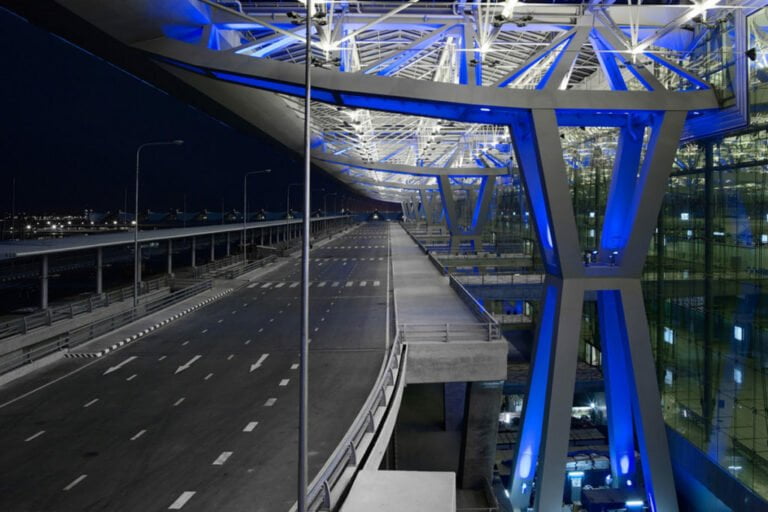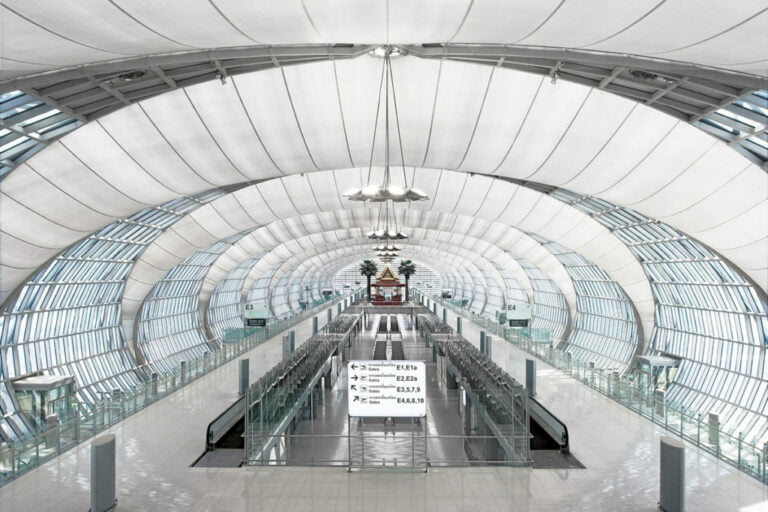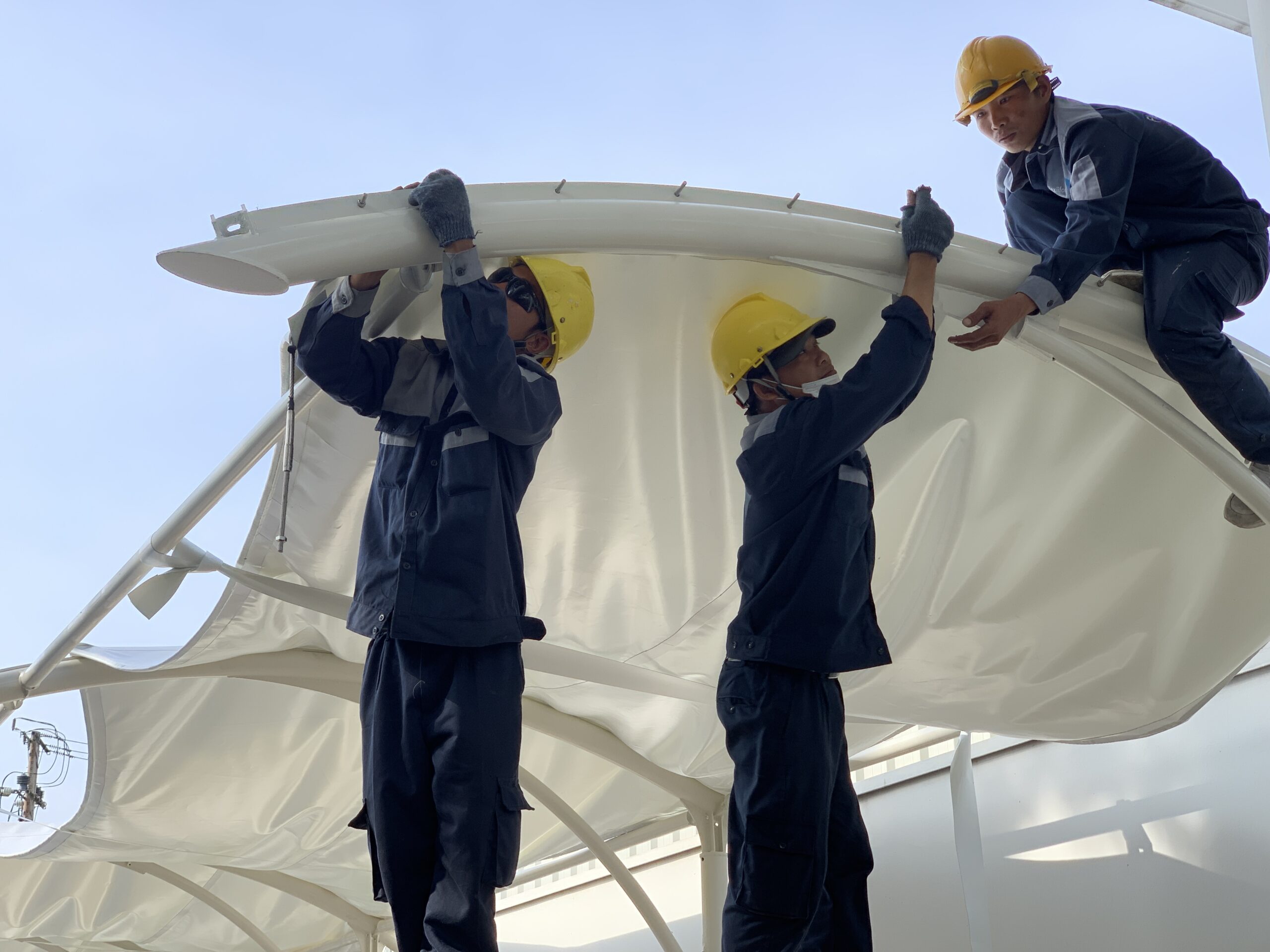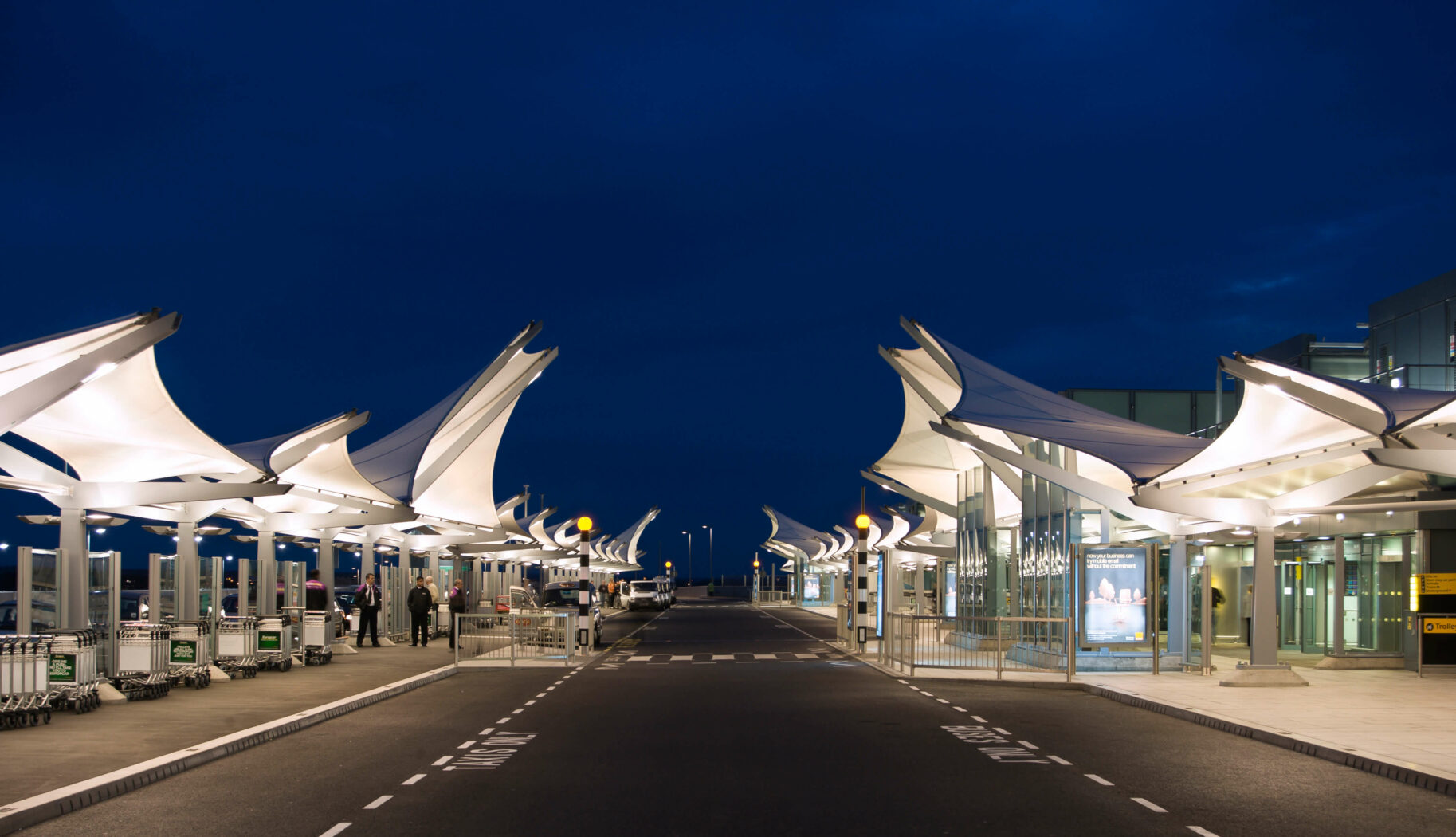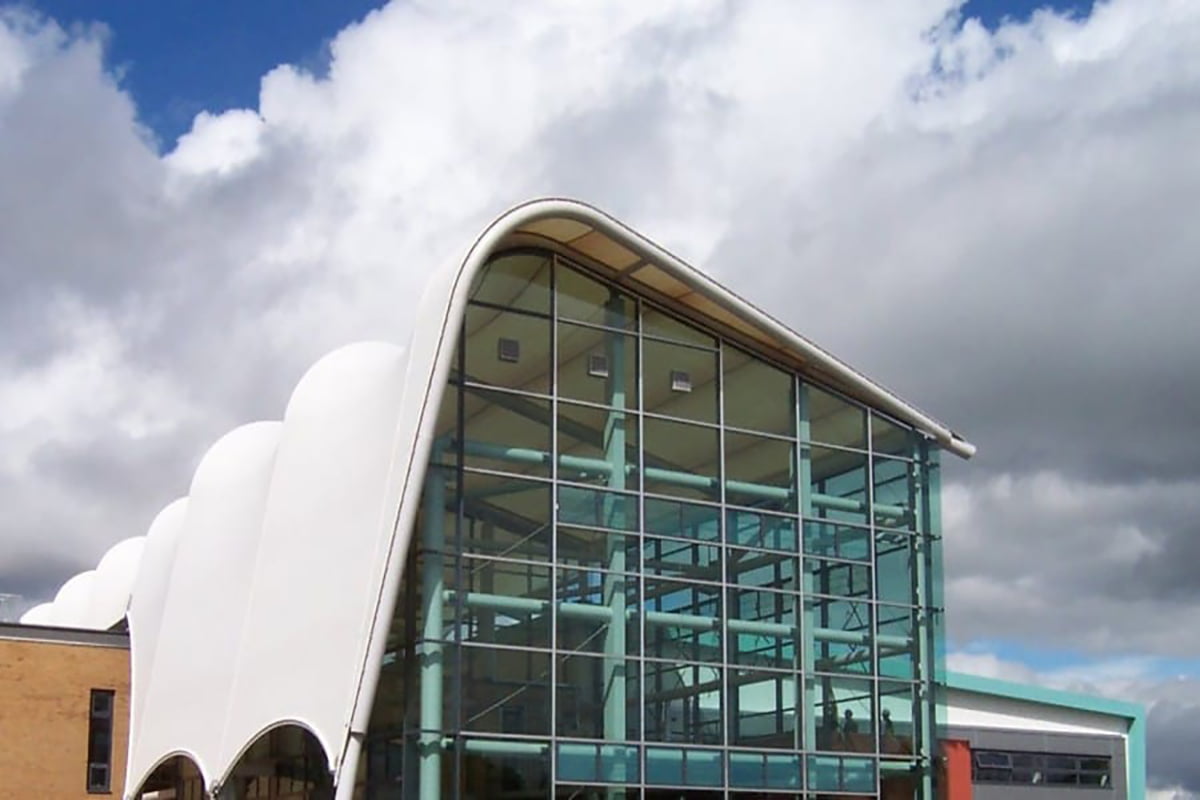Current Situation and Solution: Bangkok Suvarnabhumi Airport Canopy Design – Tension Fabric Architecture and Energy Efficiency Masterpiece
Suvarnabhumi Airport, built on a greenfield site $24\text{km}$ east of Bangkok, is a large-scale infrastructure project with an initial capacity of $45$ million annual passengers, expected to reach a maximum of $120$ million passengers after expansion. The project, designed by architect Jahn design, featuring a large truss roof structure covering the complex of functional buildings. The canopy of Bangkok Suvarnabhumi Airport is not only a key architectural element, creating an impressive image from the mainland, but also plays an important role in shading, reducing mechanical heat load and optimizing space, demonstrating a unique fusion between modern architecture and Thai cultural identity.
—
Technical Requirements Analysis & Solution Context
Suvarnabhumi Airport’s enormous size and role as an international gateway posed a number of technical challenges. The project required a roofing solution that could cover a large area ($563,000\text{SM}$ for the first phase of the terminal), effectively control direct solar radiation and heat loads in Bangkok’s tropical climate. At the same time, the design had to emphasize passenger circulation, unify the separate functional buildings and create an iconic architectural image. Energy efficiency, low maintenance costs and adaptability to future developments were also key criteria, requiring close collaboration between the architectural and engineering disciplines to create a low-energy, state-of-the-art building.
—
Technical Solutions
The masterplan and design of Suvarnabhumi Airport is a masterpiece of interdisciplinary work, with the Suvarnabhumi Bangkok Airport canopy at the heart of the architectural and engineering solution.
Roof truss structure and architectural integration
The master plan uses a station/pier concept, emphasizing passenger circulation. A large truss roof structure ($567\text{m} \times 210\text{m}$) is placed above the complex of functionally separate buildings, unifying the site and providing the dominant architectural image when approached from the mainland. The structure consists of eight super-strength girders with a central span of $126\text{m}$ and two cantilevered ends, each $42\text{m}$ long. The entire roof is supported by 16 steel frame columns. The geometry of the superstructure girders is determined by the bending moment level, shaping the architecture according to its function. The outdoor spaces between the buildings are also shaded by the roof trusses and are important to the overall concept, forming landscaped courtyards useful for pedestrians and visual amenity for passengers.
Control light, heat and materials
The Suvarnabhumi Bangkok Airport canopy is specially designed to shade the Terminal Building from direct sunlight, while still allowing diffused indirect light to penetrate the interior. To ensure longevity, high performance and low maintenance costs, factory-finished aluminium sunshades are placed on top of the roof structure. As the sunshades are positioned outside the building envelope, the absorbed solar heat is transferred to the environment through natural ventilation, creating an energy-efficient ecological solution. With the described measurements, the canopy can control the transmission of light and heat, creating a highly transparent building that meets the highest requirements for thermal and visual comfort.
The concourse area, which will accommodate passengers and vehicles, consists of 5-pin truss trusses with alternating systems of glazed facades and translucent fabric membranes (possibly PTFE as mentioned in the photo captions), which are extended to bridge the $27\text{m}$ gap between the glass facades. The facade's laminated glass is coated with sun protection and a ceramic coating of variable density; the coating is relatively dense at the top to achieve good solar protection against the high Thai sun, and tapers towards the lower sections to allow good views to the outside.
—
Results and Performance Evaluation
The Suvarnabhumi Airport project is a masterpiece of interdisciplinary collaboration, with a very convincing and surprising result. The Suvarnabhumi Bangkok Airport canopy has successfully fulfilled its function of shading, reducing mechanical loads, and effectively controlling natural light and temperature inside the terminal. This integrated design not only helps the building consume less energy but also meets the highest requirements for thermal and visual comfort, making the airport one of the most energy-efficient buildings in the world. The integration of cultural artifacts and traditional architectural elements in landscaped courtyards under the canopy has also successfully linked the terminal complex with Thai cultural traditions, enhancing the symbolic value of the building.


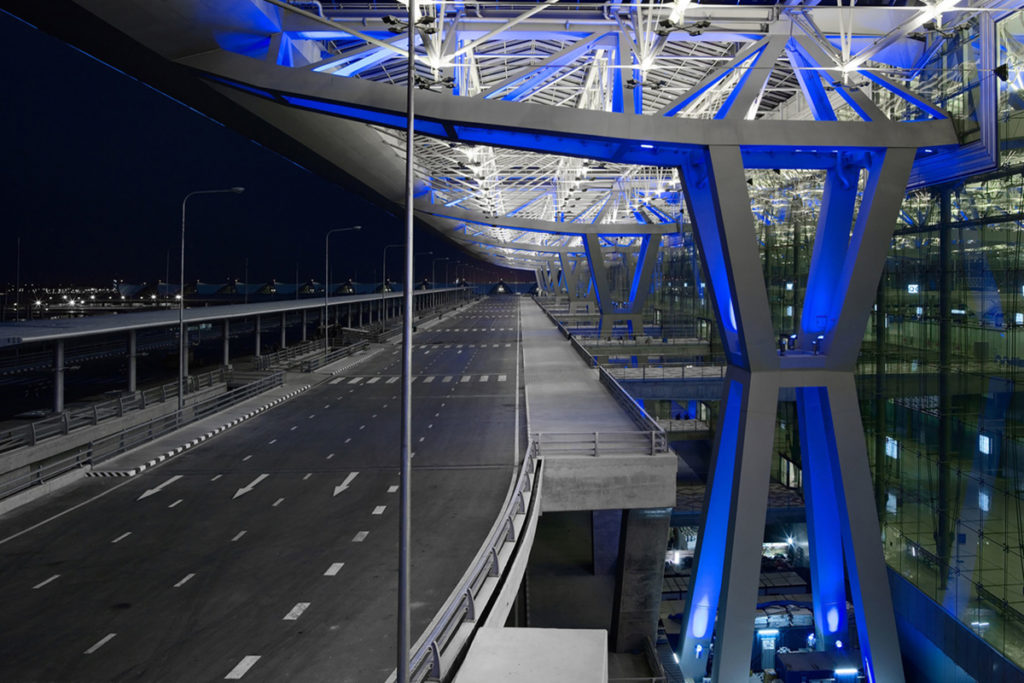
—
Contact Technical Consulting
Flexiiform is proud to be one of the leading units in Vietnam providing solutions for designing and constructing tensioned canvas. With its predecessor originating from the company FasTech, Flexiiform team gathers experts with over 10 years of experience in the industry along with a team of consultants providing the right solution according to the requirements for a variety of models and projects at home and abroad. We are committed to providing airport and large-scale construction roofing solutions with high quality, sustainability and outstanding aesthetics, similar to the Suvarnabhumi Bangkok airport roofing. To learn more about other tensioned canvas roofing solutions such as at Denver Station (PTFE & ETFE) or garden canvas canopy, please refer to related articles.
Please contact us for expert advice on stretch fabric solutions for your project.
Contact information:
Company: Flexiiform
Phone: +84 8678 68830
Website: https://flexiiform.vn/
Fanpage: https://www.facebook.com/flexiiform/


